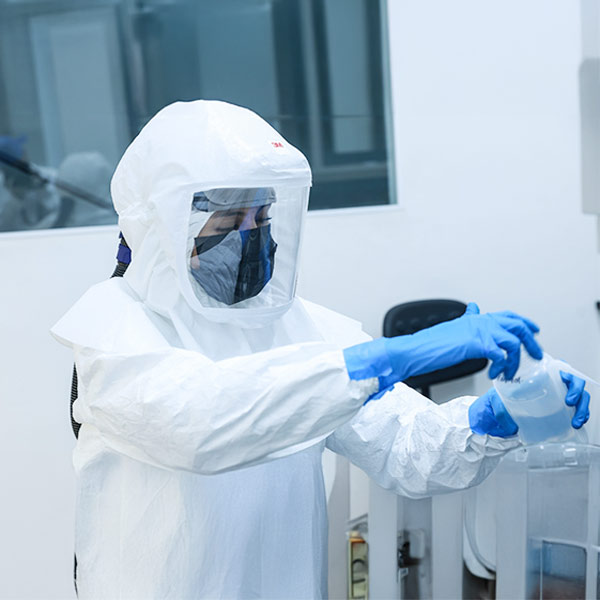
Reporter: Claudia Villalobos / Photographer: Israel Vera
The structure of the National Vaccinology Laboratory prevents the release of pathogens, supporting vaccine development without risk to surrounding communities.
For decades, the facilities that once housed the pilot food plants of the Escuela Nacional de Ciencias Biológicas (ENCB) were in use. These were later demolished, rebuilt from the ground up, and renewed in accordance with international quality standards to create a unique national asset for the Instituto Politécnico Nacional (IPN): the National Vaccinology and Tropical Viruses Laboratory (LNVyVT), a 400-square-meter Biosafety Level 3 (BSL-3) facility unlike any other in Mexico.
While the country has only a handful of high-containment laboratories, the innovation of this facility—operational since 2023—is that, unlike others that focus exclusively on bacterial studies, it is dedicated to vaccinology and the investigation of tropical viruses.
Located at the Casco de Santo Tomás, the laboratory was established to strengthen Mexico’s research infrastructure and to address—in collaboration with academia, government, and industry—critical needs related to emerging infectious diseases and vaccine development. Its mission is to respond to health emergencies such as the 2015 Chikungunya outbreak, the 2016 Zika epidemic, the COVID-19 pandemic, and, more recently, the spread of monkeypox.
BSL-3 laboratories require highly specialized construction systems and operating protocols to ensure safety, regulatory compliance, and operational efficiency.
To guarantee these standards, the LNVyVT was designed under a strict commissioning process in line with the WHO Laboratory Biosafety Manual, ensuring full compliance in the design, construction, and operation of high-containment biomedical facilities.
According to Dr. Isabel Salazar Sánchez, director and technical lead of the laboratory, this certified commissioning validates every detail—from electrical and engineering systems to doors, airlocks, and hidden passageways.
The double-height building includes a mechanical floor. Its 81 m² BSL-3 unit functions as a sealed concrete chamber with directional airflow and negative pressure, preventing the escape of any pathogens.
On the rooftop, two heavy-duty air handling units inject fresh air into the lab, while two extractors filter exhaust air through HEPA (High-Efficiency Particulate Air) filters, capturing potential pathogens before release into the environment.
Before the LNVyVT, the IPN lacked a BSL-3 facility, limiting research on emerging pathogens. “This laboratory has significantly expanded our research capacity. With its high biocontainment standards, we can now conduct studies on emerging pathogens and develop vaccines or biotherapeutics without risk to researchers or the community,” explained Dr. Salazar.
She added that the COVID-19 pandemic created greater awareness among policymakers, ultimately leading to the lab’s establishment.
“The National Vaccinology and Tropical Viruses Laboratory was born as part of Mexico’s ‘Penta Helix’ innovation model (government, academia, industry, society, and environment). It embodies a social commitment to leverage infrastructure and scientific talent in service of the population,” she emphasized.
The lab’s core mission includes articulating research projects, advancing preclinical trials, monitoring vaccine development, conducting infectious disease surveillance, and training human resources to address national health challenges.
Supported by a quality management system, the LNVyVT aims to launch high-impact projects in collaboration with universities, research centers, and industry. Among its most innovative projects is a dengue vaccine candidate developed from genetically engineered hybrid viral platforms.
In recognition of its excellence, the LNVyVT—alongside the BSL-3 Laboratory of the UNAM Institute of Biomedical Research and the Viral and Human Genomics Laboratory of the Universidad Autónoma de San Luis Potosí (UASLP)—was recently named a National High-Containment Laboratory (Lancobi) by the Ministry of Science, Humanities, Technology and Innovation (Secihti). This consortium addresses national needs in emerging and re-emerging infectious diseases through interdisciplinary research with social impact.
Dr. Salazar, a Level II member of Mexico’s National System of Researchers, highlighted that since its launch, the laboratory has advanced multiple projects in both basic and applied science for the prevention, treatment, and immunoprophylaxis of infectious diseases.
Around 30 young researchers—undergraduates, master’s, and doctoral students, along with postdoctoral fellows and interns—are actively involved in generating cutting-edge knowledge.
Current projects include vaccine candidates against Chikungunya and Yellow Fever, as well as research on Plasmodium vivax (malaria). Progress has also been made in developing adenovirus-based vaccine platforms using non-human primate adenoviruses, which are engineered with genetic “cassettes” from other human viruses to generate new vaccine candidates.
Additionally, in collaboration with the IPN’s Unidad Profesional Interdisciplinaria de Biotecnología (UPIBI), researchers are advancing a dengue vaccine candidate based on hybrid viral scaffolds created through genetic engineering.
“As in any BSL-3 facility, access to the LNVyVT requires strict entry protocols through multiple airlocks,” Dr. Salazar noted.
The lab is equipped with Class II Type A2 biosafety cabinets, two-door autoclaves for sterilization, and high-capacity centrifuges, including an ultracentrifuge capable of 100,000 rpm and a mid-range centrifuge reaching 40,000 rpm.
It also features EliSpot technology for highly specialized cellular analysis, evaluating immune memory in T and B cells. A dedicated necropsy area for rodents used in preclinical studies includes specialized cabinets for handling solvents and biological waste.
To reinforce containment, the facility uses a hydrogen peroxide-dispensing robot for surface and air decontamination. Its air filtration system operates under a UPS (uninterrupted power supply) and is backed by a diesel emergency plant with a capacity of 1,300 liters, ensuring continuous operation.
A rigorous quality management system is currently being implemented to meet international standards, enabling future patent registrations, technology transfer, and external collaborations. Training the Next Generation To complement the laboratory, the IPN established a Master’s and Doctorate in Vaccine and Biotherapeutics Science and Technology, designed to train experts capable of addressing infectious diseases of national and global relevance.
These hybrid, cross-disciplinary programs combine core courses with specialized training in participating academic units, and require technology internships for graduation.
Three years after its inauguration and two years into full operation, the LNVyVT stands as a true jewel in Mexico’s scientific landscape, advancing public health through innovation, collaboration, and excellence in vaccinology.